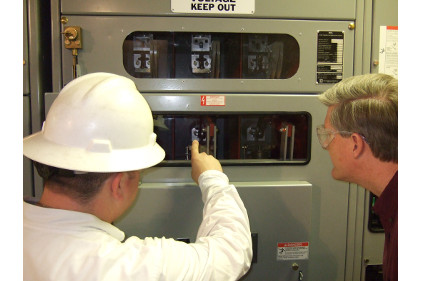You want to get the most out of any new electrical distribution equipment. That means planning up front to get a handle on scope-of-work and maintenance agreement details, and ultimately creating a lifecycle strategy for your new investment.
In today’s economy, many capital projects are on hold, and budgets and operating expenditures are being more closely scrutinized. Especially in these circumstances, it is important to remember that nothing operates without electricity. When it comes to purchasing new electrical equipment, following the manufacturer’s recommendations for use and care are critical to maximize your investment. But, is it enough to maximize the reliability of your electrical distribution system?
Generally speaking, 20 years has been the traditional useful life expectancy for electrical power distribution equipment that has been properly installed, commissioned, and maintained according to the electrical manufacturer’s recommendations. Of course, there are numerous installations of equipment that have been in operation for well over 20 years. In many of these cases, the equipment may appear to be working, but there are operational issues that need to be addressed. Even with annual preventive maintenance, there may be instances where the life span is shortened. Factors to consider include the operating environment and the availability of spare parts.
To better illustrate the above statement, think about the last time you purchased a new car. So that your car will operate per the manufacturer’s recommendations, you use the proper grade of fuel, change the oil at certain mileage intervals, rotate the tires, and schedule routine maintenance to keep the warranty valid. All are necessary steps to take so your car operates properly. But do they ensure you have reliable transportation? For example:
-
Does the owner’s manual state anything about the qualifications and experience of who will be driving the car?
-
Should special consideration be given to the operating environment (how/where the car will be driven)?
-
Are there local laws that can impact your vehicle’s performance? Last year, one state raised the speed limit to 85 mph on one stretch of highway. While most new cars are capable of reaching 85 mph, it is not advisable for safety or gas mileage.
In other words, factors exist that can affect the performance of a car which could shorten its useful life or negatively impact its reliability.
Develop a Life-Cycle Strategy for your Electrical Equipment
As mentioned above, electrical equipment has a long useful life. A life-cycle strategy should be developed for new equipment prior to installation. As part of the strategy, the following services/solutions are recommended to help maximize a company’s investment in new equipment installations.
-
Analytical studies
-
Start-up and commissioning
-
Maintenance agreements
-
Extended warranty plans
-
Training services
-
Spare parts
In addition, plans for technology obsolescence, how to upgrade system components and ultimately, modernization of the electrical system, should be topics addressed in the strategy.
Analytical studies are extremely important when it comes to the application of new equipment to provide power to a process or building. These three studies should be performed by professional engineers and implemented at the appropriate time during the project.
A short circuit analysis calculates fault-current levels throughout the electrical network to determine if the electrical equipment can withstand worst-case events. It identifies underrated or misapplied equipment. Recommendations are made to reduce high fault-current levels and to comply with industry codes and standards. A short-circuit analysis should be performed prior to release for manufacturing.
A protective device time-current coordination study determines the optimal settings/ratings for protective devices which include: relays, fuses, and circuit breaker trip units. New equipment is shipped with the minimum factory settings applied and should be installed according to the manufacturer’s specifications. This study should be completed prior to equipment energization.
During start-up and commissioning, the settings should then be adjusted based upon the results from the time-current coordination analysis. Proper setting of devices, along with verification testing, will reduce and/or eliminate nuisance tripping that could potentially occur after the system is started-up. In addition, these settings will help minimize potential equipment damage. An arc flash analysis evaluates the available incident energy and also defines the arc flash boundaries and personal protective equipment (PPE) requirements. As required by NFPA 70E, an arc flash analysis should be completed:
-
For new equipment installations
-
When changes occur to the electrical system, or
-
A minimum of every five years
In addition, NFPA 70E requires equipment to be labeled with the results of the arc flash analysis. The arc flash analysis should be completed before equipment energization. Start-up and commissioning confirms the new equipment has been properly installed, meets factory standards, and passes stringent performance tests. The on-site testing will establish the base line for future trending and analysis. Site testing is highly recommended since equipment can incur potential damage during loading, shipping, off-loading and/or rigging into position.
Scope of Work
-
Electrical testing (insulation and current path)
-
Mechanical testing (functionality and sequencing)
-
Visual inspection to ensure proper set-up and function
-
Control and protection schemes verify proper sequencing and automated operation
The following equipment should have start-up and commissioning performed per the manufacturer’s recommendations:
-
Automatic transfer switches
-
Busway
-
Cables
-
Circuit breakers
-
MV: Vacuum and SF6
-
LV: Molded case and power
-
-
Grounding systems
-
Instrument transformers
-
Motor control centers
-
Relays and meters
-
Starters (MV)
-
Surge arresters
-
Switchboards
-
Switchgear (LV and MV)
-
Transformers
-
Dry type and liquid filled
-
-
Voltage regulators
Maintenance Agreement
Once new equipment has been purchased, it is advised to begin its ‘life-cycle’ planning process. A multi-year maintenance agreement can help meet the requirements of NFPA 70E standards and also mitigate risks of unplanned downtime. Ranging from basic to complex, maintenance agreements can
be customized to cover:
-
Power equipment
-
Monitoring systems
-
Automation and control systems
-
Emergency management
-
Facility management software
-
On-site emergency response agreement
-
Preventive / predictive maintenance
-
Temporary emergency generator
-
Extended warranty
-
Spare parts
-
Employee training
Due to the technological advances in equipment, maintenance staffs now require an elevated understanding and skill set to be able to operate and maintain the equipment. As a key focus in reducing the overall operating cost, many companies look to outsource services to maintain the equipment infrastructure, enabling them to focus more on their core product offer.
Following are guidelines and questions to consider when selecting a maintenance service provider:
-
Do they have the flexibility to meet the facility’s specific requirements?
-
Do they offer payment/billing options?
-
In case of an emergency, how quickly can they guarantee a response?
-
Do they provide local, regional, or nationwide service?
Finally, it is critical to understand the scope of work that is being proposed. Pre-job site visits for estimating and project planning are highly recommended. Ask questions up front relative to the Field Personnel Competency Training to determine product knowledge. Inquire into and review the service provider’s safety training program to ensure their employees are “qualified” personnel according to NFPA 70E and OSHA requirements. Ultimately, the company outsourcing the work is responsible for workplace safety, whether the maintenance worker is an employee or a contractor.
Extended warranties are often incorporated into the specification document for new equipment purchases. While they may be purchased after the point of sale, discounts are often offered if the extended warranty is purchased at the point of sale.
As with any contractual agreement, thoroughly review the extended warranty plan. Specifically, note if parts and labor are included. Are there in/out charges for equipment or fees for expediting parts? Does the extended warranty address on-site emergency response? Finally, consider opportunities to leverage warranty extension with multi-year service agreements.
Training services — There are many benefits to workplace training. First and foremost, OSHA mandates that employers provide safe places of employment. With respect to electrical systems, NFPA 70E: Standard for Electrical Safety in the Workplace is the standard enforced by OSHA. The 2012 edition of NFPA 70E requires the development and enforcement of an Electrical Safe Work Practices (ESWP) policy.
The ESWP policy addresses topics such as lock-out/tag-out procedures, method of qualifying workers, the selection and application of personal protective equipment (PPE), methods of establishing a safe work area, arc flash and shock protection calculations, equipment labeling, and worker audit procedures.
Employees are to be trained on the contents of the ESWP policy. NFPA 70E-2012 requires the policy be audited on a three-year cycle. Should an audit determine the principles and procedures of the ESWP are not being followed, appropriate revisions to the training program or to the procedures shall be made. Workers must be evaluated for compliance to the standards and the policy; any deviations must be documented.
Training also enhances employee competency along with career development. Courses may range from broad topics to product specific. Most training providers have a diverse portfolio of options for course delivery which may include in-class, at the customer’s facility, on-line, or even virtual courses.
Verify the training provider is accredited. Questions to ask include:
-
Are job aids (workbooks, manuals, etc.) included with training?
-
What portion of the training is hands-on?
-
Are CEUs offered?
-
Are there opportunities to bundle courses to obtain price discounts?
Spare parts — Keeping spare parts on hand can play a crucial role in minimizing equipment downtime. As a rule, spare parts should be purchased at the time of the equipment point of sale, since aftermarket pricing is typically higher.
For the new equipment being purchased, identify the critical components that would have the most impact on production and, at a minimum, purchase those spare parts. If purchasing in the after-market, select OEM authorized parts to minimize any negative impact to the warranty.
Conclusion
A life-cycle strategy should be developed to enhance reliability of the electrical infrastructure, which comprises various components with a finite life. When making plans to purchase and install new electrical equipment, incorporating the steps outlined in this article can create a sound basic strategy.







